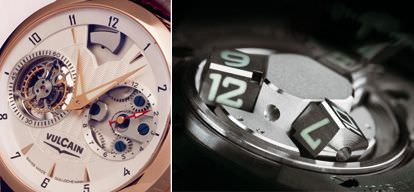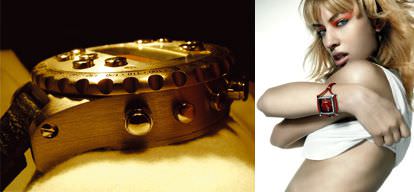Surprises outside the fair
In a small exhibition outside of the fair, Vulcain, a more modest brand but one that merits attention, presented its new models, including a tourbillon. Overwhelmed by the number of tourbillons present in Basel, we were tempted to say: “Again!” However, the one at Vulcain was indeed interesting enough for us to take a second look. Since 1947, Vulcain has been, with its first wristwatch Cricket, a grand specialist in alarm watches. After a period of half-slumber, the brand came back onto the scene in 2002, thanks to the efforts of Bernard Fleury.
After it re-launched the V-10 calibre, and equipped it with a date (V-11), the brand decided to create something really remarkable. Its Imperial Gong is a flying tourbillon (one without a fixed bridge but fixed by a ball bearing) with an alarm! You have to admit that this is rather, if not totally, unusual. With two barrels (one for the movement itself and one for the alarm), this attractive timepiece has a cathedral chime that was developed by a young engineer by the name of Luca Soprada. Remember this name. I have a feeling that we will be hearing a lot more about him in the future.
Right near there, someone who needs no introduction, Claudia Schiffer, played the role of charming ambassador for the re-launch of Ebel. Judging by the crowd that pushed and shoved against the windowed walls of the vast greenhouse where Claudia presided, it was obvious that Schiffer's effect still works. First, there was a vibrant and animated introduction by Efraim Grinberg, the happy new owner of the brand, who vigorously proclaimed that Ebel was returning to its fundamental values, and affirmed that, “We are not selling watches, but rather a vision, a strategy, and a name.” Then, it was up to Thomas van der Kallen, the new CEO, and Marc Michel-Amadry, the Marketing Director, to explain how they are going to “re-energize” the wonderful heritage of the brand (see Europa Star 2.05).
The two men displayed their own type of charm when, blushing like school boys, they began to interview the beautiful supermodel. To hear her intelligent and quick answers, one could say that, yes, Claudia Schiffer was indeed ‘ebellissima’ and that she would be the perfect ambassador for the return of a brand exuding elegant luxury without ostentation.
More ‘bombshells’
At this exact same time, TAG Heuer was launching its own ‘bombshell’ – the first mechanical chronograph with a measurement capability of a 100th of a second. With seemingly limitless energy, Jean-Christophe Babin leads probably one of the most dynamic teams in current timekeeping. Active on all fronts, from mechanical innovation to research on futuristic styling, from the intelligent use of testimonials to the judicious use of the internet (see the WorldWatchWeb article in this issue), TAG Heuer is everywhere and continues to increase the lead over its competitors.
The new 100th of a second chronograph, while it is perhaps impractical for cooking a soft-boiled egg (this is the most frequent use of chronographs), it is nonetheless a superb demonstration of the still unexplored potentials of mechanical watchmaking. The Calibre 360 Concept Chronograph is equipped with two distinct movements controlled by one single crown. The chronograph function thus has of its own rapidly rotating barrel, an escapement wheel, and a specially designed balance delivering an incredible 360,000 vibrations per hour, thus permitting the measurement to 100th of a second. (For more details on this new model, decidedly one of the most remarkable at the Fair, see our Cover Story in this issue.)
The next day, we discovered the other great sensation at BaselWorld. Harry Winston unveiled its Opus V. For the fifth time, and perhaps the last it would seem, because “how do you go beyond this,” mused Maximilian Busser, CEO of Harry Winston Rare Timepieces, the brand entrusted the realization of an exceptional piece to a young watchmaker. This year, it was Félix Baumgartner, whom we know, because at less than thirty years of age he has already made his mark in the watch world with his satellite watches made for his brand, Ur-Werk.
The Opus V is the direct descendant of a very special type of research involving new ways to measure time. In this example, another step was taken by reaching the third dimension. The Opus V is without a doubt the most surprising wristwatch that has ever been created. Let’s try to describe its operation: moved along by a cube whose face is engraved with the hour number, a large hand travels along the minute scale. After reaching 60 minutes, it detaches itself instantly from the cube and returns immediately to zero where it ‘grabs onto’ the following cube, with the indication of the next hour, before beginning its journey again. During this time, the first cube follows its rotational path and turns on itself to reveal a new face and thus a new hour. Three cubes (the ‘satellites’) display the hour number on four of their faces. Thus, 12 hours can be indicated. A sector indicator for day and night lets the viewer know if it is a.m. or p.m.
A five-day power reserve completes the mechanics of this timepiece that is as amazing as it is easy to read. Another major innovation is seen on the reverse side of the watch. It is a patented world first that is enough to make other watchmakers green with envy: a ‘Service Indicator’ operates for five years! Like a mileometer on a car, one can know exactly how long the Opus V has been running. (Europa Star will dedicate a complete article to this watch in the next issue, 4.05, on Special Mechanical watches.)

Vulcain, Harry Winston
Relative democracy
Astounded by this marvel, we began wandering down the aisles. What is really wonderful about BaselWorld is that all the different types and levels of watches are mixed up in a pot of relative democracy. Here we meet the grand ‘Lords’ and other Captains of Industry – such as, for example, the Hayek family which, each day on the Swatch Group’s immense “Plaza” at the centre of the Hall, presents a new facet of its many brands and activities (read the report by Malcolm Lakin).
At the other end of the spectrum, we also meet very young brands trying to break into the market, as well as individual watchmaking ‘fanatics’ who, without a stand but with a watch on their wrist, try to find an opening into this pitiless milieu (as are all milieus, no more, no less).
In fact, here’s one coming to the Europa Star stand. His name is John Reisman, and he spent 13 years developing ‘his’ concept. It is the Flight WatchTM, an incredible 50-mm timepiece stuffed with all kinds of electronics, which is the first to display all 37 of the world’s different time zones. (Ah, yes, there are more than 24, if you count the half-hours, or even the quarter-hours, of time differences in some countries.) The Flight Watch also has the coordinates of 76 airports, seven flight gauges, five parallel time indications, three audio alarms that are luminescent or vibrate, plus others. The most extraordinary thing is that the Flight Watch, a veritable “global system of time control,” as its inventor proclaims, does not require a 250-page user’s manual to operate it. No… everything is simply set - relatively speaking – by using the large ergonometric pushbuttons. Reisman hopes to commercialize his invention by next Autumn.

Flight Watch, Axcent
We leave our inventor and fly off to northern skies. There is something changing in the famous “Nordic design” style. Known for being purists, the Nordic designers have softened over time and have now become a bit more playful (perhaps having been somewhat influenced in return by the Italians who have taken certain of their working recipes and ‘Latinized’ them to the extreme).
A good example of this change of heart was seen at Axcent. The loquacious spokesperson of the Swedish brand affirms that the company sells more than 300,000 watches a year in Sweden alone, explaining that Axcent has “transformed the mentality of the nation, and that, in this difficult market, it has attracted a new group of consumers.” It is true that with prices between 49 and 129 ¤, it is difficult to resist the watches created by a young team who bring a rather surprising inventiveness to the pieces. As an example, the Frost model, as its name implies, contains a glass that one might think was carved from ice, behind which the hands are hardly visible. There is also the Turbo model, a sort of stone suspended from an elastic cord that lets the owner wear it in any number of imaginable or unimaginable ways – around the neck, hanging from the leg, around the middle, or anywhere else. “At such a price,” we ask in a naive voice, “is the watch made in Chinaı” “Just like everyone else’s,” answers the blond spokesperson while shrugging her shoulders at the incongruity of the question.
”China." There, we said it. China… The word embodies all of the hopes and fears of Swiss watchmakers. The progress of China’s watch industry has been so rapid, from a technical point of view, and its ability to learn the most demonic secrets of marketing so brilliant, that in their worst nightmares, Swiss watch barons see their world flooded by a large Asian wave. To understand this concern, you only had to visit Hall 6, where 347 exhibitors from Hong Kong and China exhibited their wares. Or, you could secretly visit the Swiss windows and play a little guessing game: this bracelet, that dial, these hands… where were they really madeı (Don’t miss reading the report by Malcolm Lakin for more on this subject.)
TO BE CONTINUED...
In the forthcoming days, the rest of this lenghty survey will be added to our europastar website.
BASELWORLD & SIHH: Part 1
BASELWORLD & SIHH: Part 2
BASELWORLD & SIHH: Part 3
BASELWORLD & SIHH: Part 4
BASELWORLD & SIHH: Part 5
BASELWORLD & SIHH: Part 6
Source: April -May 2005 Issue
Click here to subscribe to Europa Star Magazine.








